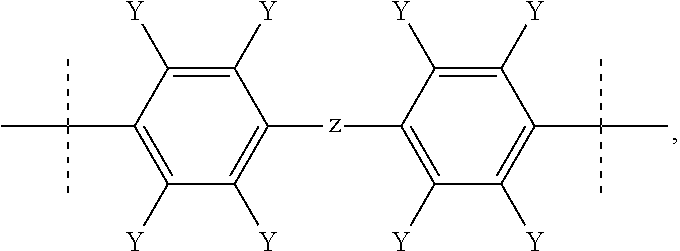Fluorinated poly(arylene ether) thermoset
a technology of fluorinated polyethylene and thermoset, which is applied in the direction of coatings, etc., can solve the problems of low entanglement molecular weight and high cost of monomers to be used, and achieve the effects of improving thermal, mechanical and chemical stability, and low dielectric constan
- Summary
- Abstract
- Description
- Claims
- Application Information
AI Technical Summary
Benefits of technology
Problems solved by technology
Method used
Image
Examples
example 1
Synthesis of F-PAEK:
[0079]40 g of 4,4′-difluorobenzophenone (DFBP hereinafter, 0.183 mol) was reacted with 64.72 g of 4,4′-hexafluoroisopropylidenediphenol (BPA-F hereinafter, 0.192 mol) and N-methyl-2-pyrrolidone (NMP, 400 mL) were charged into to a three-neck flask equipped with a N2 inlet, mechanical stirrer, and Dean-Stark trap. 100 mL of toluene and 39.9 g of K2003 (0.289 mol) were added to the flask and the Dean-Stark trap was filled with toluene. The mixture was heated to 80° C. with continuous stirring under N2 flow until DFBP, BPA-F and K2CO3 were completely dissolved. Then the temperature was increased to 150° C. to begin azeotropic removal of water. After 2-3 h toluene and water were removed from the Dean-Stark trap. Thereafter, the temperature was maintained at 150° C. for 12 h. Progress of the reaction was monitored by online GPC. After reaching the desired molecular weight the polymer solution was precipitated into deionized water. It was washed thoroughly with deioniz...
example 2
Synthesis of F-PAEK-PFS
[0082]In a 3-neck round bottomed flask equipped with a magnetic stirrer and N2 inlet, 20 g (25.35 mmol) of F-PAEK obtained as in example 1 were dissolved in 180 mL of NMP. 1.29 g of K2003 (1.3 eqv. with respect to the total amount of —OH end groups of F-PAEK) were added and stirred to dissolve at 60° C. for 2-3 h. Next, 3.344 g of pentafluorostyrene (PFS) (1.2 eqv. with respect to the total amount of —OH end group of F-PAEK) were added to the reaction mixture and the temperature was increased to 90° C. Reaction was continued for 18 h at this temperature. After completion of the reaction the amount of —OH end groups was reduced to 0, from the beginning value of 684 μeq / g. The reaction mass was precipitated in water. It was washed thoroughly with water followed by methanol. Dry polymer obtained after drying under vacuum oven at 70° C. for 6 h. Yield=83%. Mn=7600, PDI=3.2
example 3
[0083]F-PAEK-PFS was also prepared in a single step without the isolation of F-PAEK. In this procedure Example 1 was followed but before isolation of the product, stoichiometric amount of PFS (with respect to the —OH end group) was added in the same pot instead of following example 2 wherein PFS was added to the product of example 1. Mn=8800, PDI=3.4. Yield=75%. >99% end-capped product obtained as monitored by the reduction of —OH value. The formation of the end-capped product was confirmed by 1H-NMR and 19F-NMR. The spectral signals were well assigned to the magnetically different protons of the polymer repeating unit structure. In 19F-NMR, two new signals arose at −144 and −156 ppm from the tetrafluorostyrene linked to the F-PAEK, instead of three signals for free PFS. This confirmed the successful end-capping reaction of PFS to the F-PAEK.
PUM
| Property | Measurement | Unit |
|---|---|---|
| polydispersity index | aaaaa | aaaaa |
| glass transition temperature | aaaaa | aaaaa |
| polydispersity index | aaaaa | aaaaa |
Abstract
Description
Claims
Application Information
 Login to View More
Login to View More - R&D
- Intellectual Property
- Life Sciences
- Materials
- Tech Scout
- Unparalleled Data Quality
- Higher Quality Content
- 60% Fewer Hallucinations
Browse by: Latest US Patents, China's latest patents, Technical Efficacy Thesaurus, Application Domain, Technology Topic, Popular Technical Reports.
© 2025 PatSnap. All rights reserved.Legal|Privacy policy|Modern Slavery Act Transparency Statement|Sitemap|About US| Contact US: help@patsnap.com



